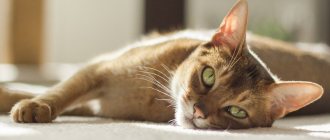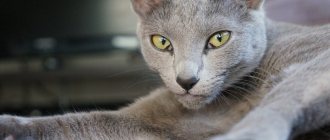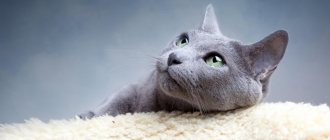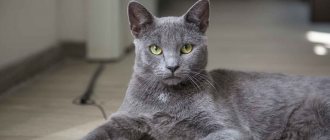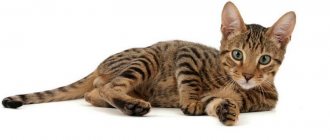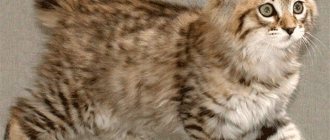Meeting a Chantilly Tiffany , shrouded in lush, deep chocolate-colored fur from crown to tail, with a dark button nose and bright yellow large eyes, can mislead a stranger. The “grimy” pet looks like it recently crawled out of a chimney. In fact, Chantilly Tiffanys are status animals. The truly lucky ones get to meet an unusual, rare cat. The owner of Chantilly is lucky: she is not only a pretty cat, but also balanced, affectionate, and not capricious.
Origin story
The first name for Chantilly Tiffany cats is foreign longhair. It is unknown how their descendants appeared, but one thing was found out for sure - the descendants of these cats were Asian Longhair and Burmese.
In 1967, breeder Jenny Robinson bought a pair of “chocolate” cats: Thomas and Shirley. A couple of years later they had offspring: equally beautiful kittens with bright eyes. Jenny immediately realized that these babies were a real treasure and began breeding the breed. Sinjin Lund, a felinologist who has been studying Burmese cats for many years, helped her with this.
Lund bought all the offspring and brought a couple of individuals to a major New York exhibition. The cats were highly rated, but they didn’t like the name of the breed – “foreign longhair”, and the similarity with the Burmese seemed too close to the experts.
For a long time the matter did not move forward. Kittens were born one by one, but the breed received recognition only in the early 90s of the twentieth century: when other breeders - Jan Deregti and Tracy Oraas from Canada - “added” Somali cats, Nibelungs, Havana Browns and Turkish Angoras to the breed.
The breed received the name “Chantilly Tiffany” to avoid confusion: at that time the Tiffany breed had just appeared in Britain.
Unfortunately, the number of nurseries has decreased over time, not increased: in 2011 there were 6 in North America, in 2003 - 1. In 2011, it burned down. All representatives of the breed died in the fire, with the exception of Frosty the cat. He was transported to a Norwegian nursery, where the last Chantilly Tiffany cat, Acie, was born.
At the moment there are no nurseries, but you can buy such a cat from private breeders.
How to choose a kitten
It is easy to distinguish a purebred Chantilly Tiffany from a mongrel kitten. In a thoroughbred:
- the fur is fluffy, soft, and looks disheveled;
- no undercoat;
- color that meets the standard is uneven, white spots are unacceptable;
- the muzzle is not elongated, without flattening of the nose;
- the outlines of the head and body are smooth;
- limbs are short, harmonious relative to the body;
- the body is strong, sinewy, the chest is voluminous, round;
- ears with pointed tips;
- eyes are big.
Healthy Chantilly kittens are active, inquisitive, non-aggressive, not afraid of strangers, and move normally. The belly is soft, moderately rounded, the ribs do not protrude, but are noticeable when palpated, the coat is shiny, there are no signs of disease or parasitic lesions on the skin.
You should abandon a kitten with watery eyes, purulent ears, an inflamed, dirty anus, red or blue gums, or bad breath.
Price
The Tiffany breed is rare, so the price is at least $500 per individual, varying slightly depending on the gender and class of the animal.
Nurseries
There are no Tiffany catteries in Russia and the CIS. The main percentage of catteries are located in the USA. Several breeders live in Western Europe and Scandinavia. Therefore, when purchasing a Chantilly kitten, you will have to add transportation costs to the cost.
Standards
The average weight of males is 4-5, rarely 6 kg. Females weigh 1-1.5 kg less.
| Standard | Description |
| Head | Wedge-shaped, with smoothed features, small. The cheeks are small, the chin is medium size, strong. The forehead is wide and sloping. The whisker pads are round and clearly drawn. The nose is neat, with a small “stop” on the bridge of the nose. The eyebrows (like the mustache) are lush and large. |
| Ears | Large, widely spaced, abundantly pubescent both inside and outside. |
| Eyes | Almond-shaped, the color of the iris is all shades of yellow. |
| Frame | Small, graceful, with well-developed muscles. The limbs are slender, with oval, densely pubescent paws and small, but sharp, claws. |
| Tail | Long, with a sharp tip. Abundantly pubescent. |
| Wool | So thick and long that it gives the animal massiveness and significantly increases its size. The fur is soft, velvety to the touch, does not stick together and practically does not get dirty. Sheds little. |
Significant disadvantages:
- Different color;
- The eyes are green;
- Short hair on the body;
- White medallions;
- Lack of fluffy “pants” and “collar”.
External data
According to the photo of Chantilly Tiffany, this is a cat with a slender and slightly elongated body type.
- Her body weight is more than 5 kg;
- It has soft, medium-length fur that hangs beautifully and evenly. The breed has no undercoat, which is why there is no risk of tangles. The collar and tail area are always a little fuller;
- The head is small, wedge-shaped. The muzzle is wide with prominent cheekbones;
- The eyes always stand out against the background of the fur coat. They are large, oval and in shades of amber or close to it.
Character and behavior
A furry weasel is what breeders kindly call Chantilly Tiffany. This breed is ideal for indoor keeping. Once in your house, the animal will quickly choose one person - its favorite one - and will constantly follow him like a little dog, waking him up in the morning and waiting near the front door after work. And, by the way, under the toilet door too.
It is communication with a person that Chantilly gives preference to. They are soft and reserved, are not afraid of strangers, willingly go to meet guests, but do not allow liberties with themselves. They are easily frightened: if a guest makes a sharp gesture or raises his voice, they quickly retreat to a secluded corner and watch the further development of events from there.
Restraint is another of their distinguishing features, but they also do not shy away from games. Especially if their beloved owner or other pets (with which, by the way, these cats get along very well) will participate.
Chantillies are smart and grasp information on the fly, so they are easy to teach tricks and commands. They look at new objects with interest, and if the owner teaches them through play, then the process will be fun and easy.
They quickly adapt to new places and conditions. But they cannot stand loneliness. This is a real punishment for them! If Chantilly is left alone often and for a long time, she will get sick more often and gradually turn into a real savage.
The cat loves to walk in the fresh air, but letting her go out on her own is very dangerous. A friendly Chantilly Tiffany can be suitable for acquaintance not only with a cat, but also with a dog that can show aggression.
And there are many other dangers lurking for a cat: cars, poisons, and cold. And fleas and ticks brought into the house are unlikely to bring you much joy.
Chantilly Tiffany are more talkers than silent ones. If you prefer quiet, they are not for you.
Chantilly - especially at a young age - are very curious creatures. By trying to stick their nose into all the corners and pots, kids can get an electric shock, burn or other injury, so take precautions in advance: hide all wires away, put special nets on the windows, remove toxic plants, sharp and breakable objects.
Breed Features
This is a rare breed, but popular among cat lovers who prefer animals with beautiful long hair. Chantilly Tiffany has a flexible, slender body covered in chocolate-colored fur. The coat goes down in waves and elegantly frames the neck and ears, creating a fluffy tail. Cats have a wedge-shaped head with soft features and a wide muzzle.
Expressive oval eyes are widely spaced and attract with their amber color. Animals' ears are small in size, rounded at the tips. As for the colors, variations are possible, although at first a dark brown tone was allowed. Now you can find several colors: chocolate, blue, lilac, fawn and synamon.
Colors can be solid, spotted, striped, tabby and mackerel.
Care instructions
Wool
The Chantilly does not have a thick undercoat, so this breed does not require daily brushing. 1-2 times a week is enough. Brush – only a special one: metal, with rounded teeth (or a rubber glove).
Bathing
Clean cats are good at taking care of themselves, but they still need to be washed from time to time. Not too often (frequent bathing washes off the protective layer and causes skin irritation) - once every 3-4 months and, of course, before the exhibition. But it should be borne in mind that representatives of the Chantilly Tiffany breed categorically do not like to swim: they break out, squeak indignantly and express their dissatisfaction in every possible way. Therefore, it is advisable to enlist the support of an assistant who will hold the animal.
Does your cat like to swim?
Not really
Make sure that water and detergent do not get into your cat's ears or eyes. You can insert cotton swabs into your ears and put a rubber cap on your head. Use only special products for cats (semi-long and long hair). After bathing, gently dry the coat with a towel, but do not rub too hard, otherwise it will become tangled.
Eyes
Inspect your eyes daily; if necessary, wipe off discharge with a cotton swab dipped in chlorhexidine or warm boiled water. It is not recommended to use tea leaves or chamomile infusion: Chantilly wool may take on an unnatural shade.
Ears
The ears are inspected and cleaned weekly using a cotton swab dipped in ear lotion or chlorhexidine.
Teeth
Teeth are brushed once a week using a special toothbrush and toothpaste (Beaphar, Trixie, Cliny).
There are a huge number of cleaning products in veterinary pharmacies and pet stores. Therapeutic, preventive, refreshing, with the taste of mint, fish or meat, with bone meal, specialized tooth powder, special pads...
If your pet meekly allows you to brush its teeth, the problem is easily solved, but what if not? You will have to take him to the veterinarian every year for laser cleaning, and at home you will have to drip gum-cleaning gel into the drinking water.
Expert opinion
Dusheba Vera Ivanovna
In 2010, she graduated from the Moscow State Academy of Veterinary Medicine named after K.I. Scriabin with honors, specializing in veterinary medicine. I regularly attend veterinary conferences, congresses, and webinars.
If your cat's gums turn red and begin to bleed, there is an unpleasant smell from the mouth, hard, yellowish formations appear on the teeth, and there is swelling on the gums - show the animal to the veterinarian.
Claws
Nails are trimmed once a month using nail clippers or a special nail clipper. Be careful to trim the very tip of the nail, being careful not to catch the vessel at the core.
Pictured are kittens of the Chantilly Tiffany breed
Feeding
Remember that domestic cats are very prone to obesity and overeating, so you need to carefully monitor the frequency of meals, which should not exceed 2 times a day. Choose food that your pet likes.
Be sure to make sure that the food is appropriate for the kitten’s age, which will allow you not to worry whether your pet is getting enough to eat or not. Some breeders claim that cats eat dry food just fine, others say that natural food is preferable. It should be remembered that with completely natural food, it is necessary to periodically introduce vitamins, microelements, and plant fibers into the diet in the form of raw grass or a special supplement from a veterinary pharmacy.
The basis of the diet during natural feeding should be lean meat, sea fish, and eggs. It is necessary to dilute the menu with porridges, for example, buckwheat, barley, and vegetables (zucchini, carrots). Avoid giving cats starchy vegetables such as potatoes, green peas, and boiled beets. Chantilly-Tiffany's favorite treat is fruit.
But you need to be very careful with confectionery products, as pets quickly get used to them. They begin to demand treats, as a result of which they quickly gain weight.
Catering
Representatives of this breed tend to gain excess weight, and in a fairly short period of time. Therefore, you must strictly adhere to the recommended proportions and not follow the lead of your pet, who touchingly looks into your eyes and begs for another tasty morsel.
Chantilly Tiffany are amazingly capable actors. If they notice that you reacted positively to their plaintive cries and body movements, they will organize a concert over and over again.
The feeding rules are:
- Adults (over 6 months) should be fed 2 times a day: morning and evening. After eating, bowls should be washed thoroughly (without using chemical detergents). If a cat smells the stench of spoiled food, it will refuse to eat from this dish. Babies are fed 3-6 times a day: the younger the kitten, the more often feedings are carried out. Exceptions also include pregnant and lactating, exhausted and sick animals. Their menu and feeding schedule are discussed with the veterinarian.
- You cannot mix ready-made food and food prepared by yourself. To digest both the first and second, different enzymes are required.
- Clean water at a comfortable temperature (not hot, but not from the refrigerator) should be present in the drinking bowl at all times! Do not feed your cat liquid from the tap: it contains too much chlorine, iron and salts harmful to the animal. A household filter can remove them. You can settle the water (10-12 hours in a dark place, without covering the container with a lid) or buy bottled water.
Natural products
The menu should contain the following products:
- Meat is of good quality and low-fat varieties. These are beef, veal, rabbit, turkey, lamb. The meat is not boiled, much less fried, but pre-frozen in the freezer for a day or two. Before feeding, defrost, pour over boiling water and cut into small pieces. A kitten needs 30 grams per day, an adult cat needs 100-120 grams.
- By-products: liver, stomachs, hearts, kidneys. They can be given raw (except for the liver: it is too heavy for the stomach) or boiled. It is better to grind chicken necks into minced meat.
- Fish: salmon, rainbow trout, cod, chum salmon, halibut, pink salmon, flounder, sardine, tuna. All fins and sharp parts must be cut off from the fish, scales and bones must be removed. You can feed it either raw or boiled (without salt or seasonings). You cannot constantly feed Chantilly Tiffany with fish: the animal’s thyroid function and metabolic processes are disrupted, iron is poorly absorbed, and urolithiasis develops.
- Rice, buckwheat, oatmeal, barley, millet porridge. They are boiled in water; you can add just a little milk for taste. Children cook semolina porridge by adding a drop of honey.
- Fresh or boiled milk is given to kittens up to 3 months. In adult cats, it often causes digestive upset, but if your pet loves it and does not have stomach problems, you can leave the product.
- Boiled chicken yolk (pure or mashed with milk, kefir, yogurt). Give 1-2 times a week.
- Fermented milk products: fermented baked milk, kefir, cream (10%), yogurt, low-fat cottage cheese, natural yogurt, sour cream, unsalted hard cheese. Can be given every day.
- Boiled quail eggs – 3-4 times a week.
- Raw or cooked vegetables: pumpkin, carrots, zucchini, green beans, broccoli, cauliflower, greens (dill, parsley, spinach, lettuce).
- Dry brewer's yeast - 3-4 times a week.
- Vegetable oil: olive, sunflower, flaxseed – half a teaspoon per porridge.
- Vitamins.
To cleanse the stomach of cats, they grow wheat, barley or oats. The animal will nibble on green sprouts at will.
Your cat should always have fresh water, free of chlorine and harmful impurities, at a comfortable temperature. Water can be bought in a store, purified through a regular filter, or left to stand for a day.
It is prohibited to give:
- Pork, duck meat, goose meat, lamb (the body does not digest fatty meat well, in addition, the meat of these birds is often infected with worms);
- Rotten, smelly meat;
- Bones (a cat might choke), tripe, lard;
- Butter;
- Sweets: candies, pastries, cakes, marmalade, marshmallows, marshmallows, sugar, chocolate (chocolate is poison for cats, other foods are poorly digestible and disrupt metabolism);
- Salt, spices, seasonings (not absorbed by the body);
- Human canned food, sausages, sausages, smoked, dried, fried, spicy, fatty foods (disturb metabolism);
- Beans, peas, chickpeas, soybeans, potatoes, tomatoes, eggplants (not digestible, cause stomach upset);
- Vitamins and medicines for people (can cause severe poisoning, even death);
- Dog food (not digestible).
Recommended food
Ready-made foods are convenient and easy to buy (or order online). There are many different lines for animals of all ages, in addition, the presence of chronic diseases and the characteristics of a particular animal are taken into account (for example, for cats with long hair, with a sensitive stomach, etc.).
Cat foods of the economy and premium classes are significantly cheaper than foods of the super-premium and holistic classes, but they also differ greatly in quality.
Firstly, there is practically no pure meat in them (or none at all), and the combination “meat waste” hides food production waste: ground bones, skin and feathers.
Secondly, they are low in vegetables and nutrients, and have an abundance of unnatural preservatives, dyes and flavor enhancers. Of course, your pet will be able to eat, but such food will not benefit its health. Therefore, choose holistic food Orijen, Power of Nature, Wellness CORE and super-premium Leonardo, Naturea, Sanabelle.
Below are recommended super-premium foods. Links with the names of the food are clickable, on them you can, within our website, get acquainted with the descriptions of the food and read reviews from owners of Chantilly Tiffany cats.
| Holistic | Holistic | Super premium |
| One&Only | Savarra | Superpet |
Colors
At the beginning of their development, Tiffany cats were exclusively chocolate in color. The following colors are acceptable as standard:
- dove-blue;
- lilac;
- beige;
- cinnamon.
Some representatives have fur decorated with a tabby mackerel pattern.
Tiffany Chantilly with popular colors
Description of character
Despite her balance, independence and complaisance, Chantilly Tiffany cannot be classified as a pet that constantly reclines on the sofa. They are very active and playful, although the activity does not last long. Cats observe moderation in everything.
This is truly an ideal pet, suitable for keeping in an apartment. The cat chooses a leader for itself in the form of an owner, to whom it will be devoted. However, she will not impose herself and demand increased attention.
He will just sit next to him and watch.
Such cats find it difficult to tolerate loneliness and neglect. Children are treated well, but they will not take part in their active games.
It’s better for them to hide somewhere so that the kids don’t hit them in their excitement. Other pets are treated tolerantly. By nature, Chantilly is not demanding, quiet, pliable. They love their owner, never show aggression, and are easy to train. They treat strangers with extreme caution and distrust.
Diseases
All the advantages of Chantilly Tiffany cats include their good health. To date, no hereditary diseases have been identified. But these animals also have some peculiarities.
- Firstly, the breeders directly indicate that the digestion of Chantilly Tiffany is very sensitive. A menu rich in grains does not suit them. They also have a negative attitude towards frequent changes of diets and feeds.
- Secondly, half of Chantilly Tiffany suffers from tartar and related oral diseases. Therefore, pay special attention to caring for your cat’s teeth and gums.
Deworming once a quarter is mandatory, as are annual vaccinations.
Breeding Chantilly-Tiffany
Since the Chantilly Tiffany is officially considered an extinct breed and very few enthusiasts breed it, it will be extremely difficult to get two kittens of different sexes and not related. Especially considering the price of kittens, which starts at $700.
You can only buy Chantilly abroad. This is easiest to do in America, Great Britain or Scandinavia. If you buy kittens for breeding, make sure they meet the standard.
Chantilly Tiffany is difficult to find and buy
Breeding Chantilly Tiffanys is no different from breeding other cats. It is even easier to do this, since you do not need to register cats in the club, participate in exhibitions and fight for the right to breed (title page or breeding assessments). It is advisable that the person who undertakes the breeding of Chantilly already has experience in breeding cats. Ideally, have your own small nursery.
There are no pitfalls in breeding Chantilly - they are not susceptible to hereditary and genetic diseases, and childbirth usually occurs without complications. The main thing is to follow the correct regime and monitor the health of your pets.
Breeding Chantilly-Tiffany can only be entrusted to an experienced person


